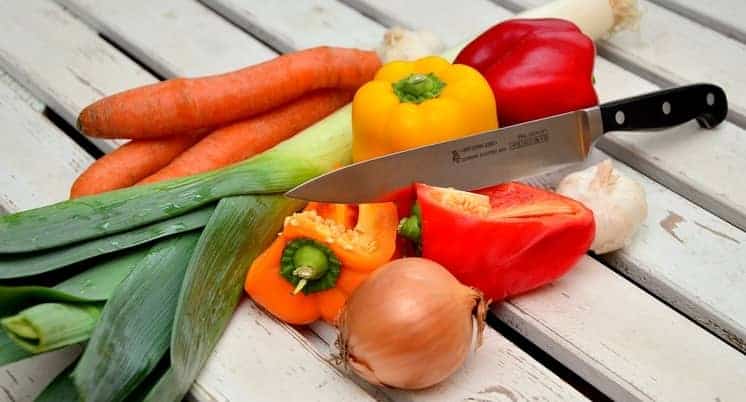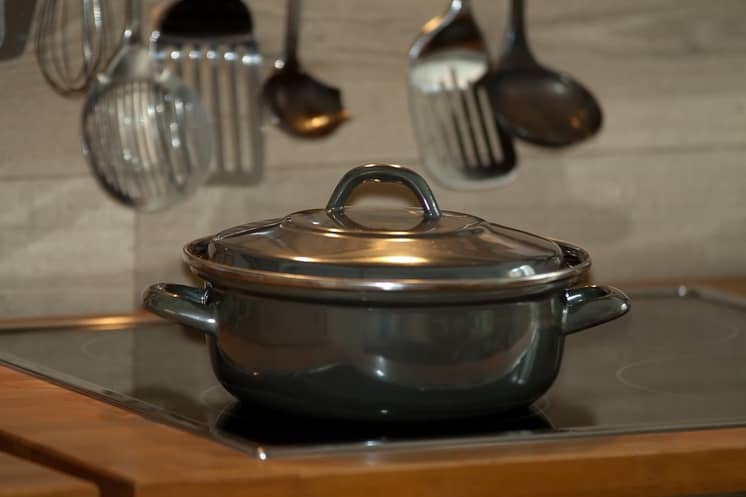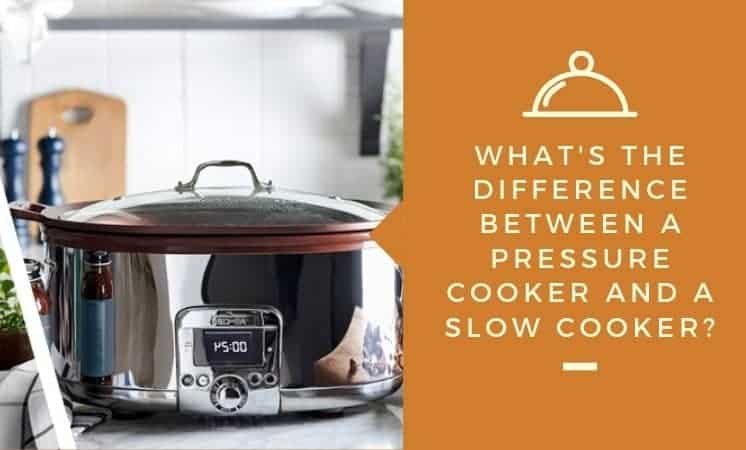When it comes to hands-off cooking, there are very few counter-top appliances, save the slow cooker and pressure cooker, that allow you to set your food up and walk away for the day, only to come back home to a hot homemade meal.
Due to our hectic lifestyles and staunch reluctance with having to clean up afterward, a market was born for both of these types of appliances as cooking healthy was, and still is, considered mandatory despite our go-go-go nature.
Both of these appliances are fantastic tools for conveniently cooking dishes that would otherwise require a lot of heavy lifting on the cooker’s part but while they both produce very similar results; they couldn’t be more different from one another.
So, what’s the difference between a pressure cooker & a slow cooker? The main difference between these two appliances is that the pressure cooker uses steam heat and pressure to cook your food faster than conventional methods while the slow cooker uses low moist heat to cook your food over a long period of time.
Although this is the main difference, the actual cooking process that these two appliances use also differs, what they are able to cook differs, and there is a difference in maintenance, opening methods, and types of models available.
The Cooking Process: Pressure Cooker vs. Slow Cooker
Although the pressure cooker is a bit more complicated than the slow cooker in terms of the cooking process and ease of use, once you’ve used it a few times you can generally get the hang of it. With a pressure cooker, you seal both the food and the cooking liquid (water) in the pot by locking the lid down.
The liquid will be brought to a boil and steam will form, increasing the amount of pressure inside the pot. The amount of pressure inside the pot will not only determine how fast your food cooks but how tender your food comes out as. It is important to note that most pressure cookers can reach upwards of 250 degrees Fahrenheit
A slow cooker, as the name implies, uses moist heat to cook your food over a long period of time which can range anywhere from four to twelve hours. The food is placed within the slow cooker pot which is then placed within the heating unit and is covered by the lid.
The slow cooker is then set to a low or high-temperature setting and is left alone until the required time has passed. With some recipes, you may need to stir the food every once in a while.
Are Pressure Cookers Better Than Slow Cookers?
The answer to this question is dependent on which angle you take and with an understanding that the answer is a subjective one based on several factors including personal experience.
With this said, many individuals lean towards the pressure cooker being far superior to the slow cooker with regards to food quality, cooking temperature, the Maillard browning reaction, and convenience.
- When cooking tough meats and heartier vegetables, a pressure cooker is always going to tenderize them better than a slow cooker. If you are cooking food items that have a lot of starches to them, you are going to get a thinner result in a slow cooker than if you were to cook them in a pressure cooker. This is just simply due to the higher temperature range than a pressure cooker utilizes.
- Foods that are cooked in a slow cooker will not experience any reduction or browning because of the ceramic insert. It is much harder to build the flavor as a result because the moisture that evaporates will condense and drip back down into the food, cooling down the surface of the food. This means that no enhanced heat gets to the top of the food. With a pressure cooker, you are going to get some Maillard browning action throughout the food because of the higher temperature.
- In terms of food planning and preparation, the slow cooker might be easier to use because you simply throw everything in and set it. However, it does require some planning and organization as you will need measure out your ingredients, sear or sauté them if you want a lot of flavor before adding them, and it is a pain to transport. Although you have to plan and organize, sauté and measure with a pressure cooker as well, you can do this right in the vessel without needing additional cooking appliances. Plus, you can be completely unprepared and still come out with a delicious and complicated meal with a pressure cooker within half an hour.
- Pressure cookers deal with beans and vegetables a lot better than slow cookers, which will make them mushy if left too long.
- A pressure cooker can be used as a really big pot whereas a slow cooker cannot be used for anything else other than slow cooking.
- Pressure cookers are also more energy efficient since they require less on-time and they use less liquid, so they are less of a hassle to clean up afterward.
- Pressure cookers are great for individuals who live at high altitudes as the boiling point of water goes down the higher up you go. This means that foods like beans and lentils will take much longer to cook or end up never getting cooked through traditional cooking means. A pressure cooker can get the job done regardless of the altitude.
If you don’t mind waiting for your food when you get home, a pressure cooker is going to provide you with superior results in terms of taste, quality, and flavor.
Can I Use My Pressure Cooker as a Slow Cooker?
Yes, you can. However, be prepared to completely adjust slow cooking recipes so that they work properly in your pressure cooker. Also note that there are several slow cooker ingredients that will not work well in electronic pressure cooker models such as dairy and milk, recipes that use arrowroot powder and corn starch, cream-based soups, and recipes that call for wine. Why?
- Dairy products will burn because the pressure cooker will cook too fast for these to fuse with the rest of the food.
- Recipes that use thickeners like corn starch will need to be added in after the pressure is released or the starch will burn.
- If your recipe calls for flour, you have to do this separately as the flour will prevent your pressure cooker from building pressure.
- Wine has to be added after the pressure is released and the lid is removed. The flavor of wine does not change under pressure and so you may get an undesirable taste.
- If your recipes call for tomato paste, mix in after the pressure is released as it will not mix well with liquids beforehand.
Can a Pressure Cooker Replace a Slow Cooker and Vice Versa?

While you can achieve similar results with both these appliances and prepare the same recipe in both, they don’t really substitute for one another. Their methods differ vastly and any recipe made for the slow cooker must be tweaked to fit the pressure cooker and the other way around.
So, yes, it is possible to cook tender and juicy meals in both of these cookers, but the time it takes to cook a meal varies greatly between these machines.
The pressure cooker is a fast cooker that requires the user to be present or nearby while cooking while the slow cooker is a, well… slow cooker and can be left unattended during the 8-12 hour long cooking cycle because it operates at low temperatures.
Seeing as the slow cooker is the only alternative that you can leave unattended, and the pressure cooker is the only appliance capable of cooking with such speed, the case can be made for owning both of these appliances.
If you don’t have sufficient funds for both a pressure cooker and a slow cooker, you may want to take a look at an Instant Pot (an electric pressure cooker capable of doing both).
Instant Pots are, just like pressure cookers, much faster than slow cookers, they also require the user to be in proximity to the appliance while cooking, for safety reasons.
Are Slow Cookers and Pressure Cookers Energy Efficient?
Must of us have no idea how much energy the electronics we use on a daily basis consume. Electronics that are energy efficient will save money in the long run – especially if they are used frequently.
Pressure cookers are very energy efficient, not because their heat source isn’t powerful and exhaustive to run, but because of how quick they run a full cooking cycle. You can expect to cut both cooking times and energy consumption by 70% in a pressure cooker in comparison to other conventional methods of cooking.
Well, what about slow cookers then? A full cooking cycle can take up to 12 hours – will a slow cooker ruin me?
Slow cookers are more expensive to run than pressure cookers, there’s no question about that. But still, when comparing the slow cooker to other conventional methods, the slow cooker is also quite energy efficient.
Slow cookers come with different temperature settings, these have a strong impact on how much energy the slow cooker will consume. Cooking a meal on the low setting takes about 8 hours, while the high setting takes half the time.
Another thing to take into consideration is the fact that pressure cookers require minimal amounts of water to cook – just enough to produce steam pressure. Slow cookers require far more liquid when cooking.
When it comes to saving dollars, the pressure cooker definitely wins.
High Altitude Slow Cooking and Pressure Cooking

In the US alone, there is a multitude of cities that are located far above sea-level. In fact, one-third of the countries population reside in high altitude cities. Cities that are located 3000ft above sea-level are considered high-altitude cities.
Cooking in such environments takes more time than cooking at sea-level because there’s less atmospheric pressure at high altitudes – this reduces the temperature at which water boils.
At sea-level, water boils at 212F, and at 2000ft, it starts to boil at 208 Fahrenheit. Because the temperature of the boiling water is cooler at high altitude than it is at sea-level, it also takes more time to prepare a meal. The higher you go, the thinner the air and the less atmospheric pressure there is, this results in longer cooking times.
The slow cooker, which cooks slowly at sea-level, requires even more time to cook a meal at high altitudes. Pressure cookers, on the other hand, are actually very convenient at high altitudes because they can build up steam-pressure.
Increasing the pressure inside the cooker also raises the temperature at which the water inside the vessel cooks, this reduces the cooking time. Pressure cooker recipes must, therefore, be adjusted when cooked at higher altitudes.
- Altitude / Cooking Time
- 3000 ft / +5%
- 4000 ft / +10%
- 5000 ft / +15%
- 6000 ft / +20%
- 7000 ft / +25%
- 8000 ft / +30%
- 9000 ft / +35%
- 10000 ft / +40%
- 11000 ft / +45%
- 12000 ft / +50%
Are Pressure Cookers and Slow Cookers Easy to Clean?
Both pressure cookers and slow cookers should be cleaned after each cooking cycle, this is true for most items and appliances that are used to cook food. Hygiene is very important when handling food, and a subpar cleaning routine may create an environment where bacteria can grow – we don’t want that.
Knowing that you’re going to spend some time cleaning the machine every time you’ve used it raises the question: Are these cookers easy to clean?
Pressure Cooker
Pressure cookers come in different variations:
- Electric pressure cookers
- Stovetop pressure cookers
Both consist of 4 components, the first is the actual container, the second is the lid, the third is the sealing ring placed between the container and the lid, and the fourth is the valve which drops when the cooker has pressurized.
The primary focus when cleaning a pressure cooker is to make sure that there’s no food stuck in the sealing ring rack or on the actual ring. If there’s food stuck on the sealing ring or its rack, the pressure cooker will have a hard time sealing.
Without the gasket (the sealing ring) in its place, the steam pressure will escape and the pressure cooker will be rendered useless. These rings should be replaced annually.
With that said, you should know that modern pressure cookers also come with dishwasher-safe parts. You can find out which components are safe to put in the dishwasher by reading the instruction manual. Parts that aren’t dishwasher-safe can be washed in a bath of warm water and soap.
If you happen to burn food in a pressure cooker there will be hard-to-remove stains on the pressure cooker’s insert. Contact the manufacturer or read the instruction manual to find out if you can use strong chemicals when washing the pressure cooker.
If they advise against strong washing agents, use a milder option and let it soak in the pressure cooker for 30-60 minutes. The stains will gradually loosen up. After 30-60 minutes, wash the pressure cooker with a soft sponge. When there’s no debris left, let the appliance dry.
Slow Cooker
With every slow cooker, there should be an instruction manual that tells you what kind of material you can use when cleaning the cooker. No matter what type of material your cooker is made of, it can most likely handle warm water and soap. For tougher stains, you may need baking soda, ammonia, and vinegar.
Most slow cookers come with removable parts, these can be detached and cleaned separately in a gentle manner – using only warm water and soap.
- Unplug the appliance from the socket when cleaning.
- Using a damp cloth, wipe the slow cooker’s base gently to get rid of the easiest stains.
- Remove components that can be removed and clean them carefully
- Wipe the appliance with a paper towel
- To remove tougher stains – mix baking soda and water to create a paste. Then use the paste to cover stains and let the mixture react before gently scrubbing it off. Use a soft sponge, scrub or toothbrush to remove tough stains.
Just like most appliances used to cook food in, these two require the user to clean them frequently but they are not very hard to clean. It rarely takes more than 5 minutes to clean them thoroughly – unless you’ve burned the bottom of the cooker badly.
Are Instant Pots and Pressure Cookers the Same Thing?
Yes and no. An Instant Pot is a multi-cooker that offers the same functionality as a steamer, a warming pot, a rice cooker, an electric pressure cooker, and a sauté/browning pan.
For all sakes and purposes of this article, an Instant Pot can be classified as an electronic pressure cooker (brand) that does not require the use of a stove. It comes with a built-in heating device, internal thermostat, and a digital display similar to that of numerous pressure cookers on the market.
The Instant Pot comes with an automated system that controls the temperature and inner pressure of the cooker with the help of sensors. These sensors react when the Instant Pot’s pressure decreases, and as a response, it activates the heating element to increase the temperature, which results in more steam pressure.
Thanks to the Instant Pot’s ability to regulate these things automatically, the heating element can be used periodically, when needed.
Ever since I bought my Instant Pot, I’ve been using it on a regular basis. I was amazed by how well it cooked and how easy it was to operate. It didn’t hurt one bit that the model I bought is cheap on Amazon.
Stovetop pressure cookers, on the other hand, must be operated manually and require more work to get just right. Both the temperature and pressure must be controlled by the user – this gives the stovetop pressure cooker a larger learning curve in comparison to its electric counterpart, such as the Instant Pot.
Are Slow Cookers and Crock Pots the Same Thing?

Yes, they are the same thing. A Crock Pot is a specific brand of slow cooker that has unique features that differ from other off-brand slow cookers. The main difference between a Crock-Pot slow cooker and any other slow cooker is that the Crock Pot will heat from both the bottom and the sides of the cooking unit whereas, other slow cookers only heat from the bottom.
Other than that, they produce the same kind of delicious results and contain the same three components: a lid, a pot, and an internal heat source.
A Crock-Pot is always a slow cooker but a slow cooker is not always a Crock-Pot, it may sound strange but that’s really how it is. Crock-Pots are designed as slow cookers but come with other features that many other slow cookers don’t have.
Pressure Cooker and Slow Cooker F.A.Q
Which slow cooker would you recommend? Well, I’ve got a favorite cooker that I always recommend to my friends. You can’t go wrong with it. It’s a high-quality product with a low price tag and a bunch of features. It’s the Black & Decker and you can find it on Amazon.
Are pressure cookers worth it? Definitely. I’ve spent cash on things that aren’t worth it before, thousands of times, and let me tell you, my pressure cooker isn’t one of those. I don’t plan most of my meals as I did before, the process of cooking has now been reduced to chopping the ingredients and placing them in the cooker – the rest is handled by the appliance. It rarely takes me more than 10-15 minutes to prepare a meal, then an additional 30-40 minutes until the meal is ready to be served.
Do pressure cookers remove nutrients? This question appears once in a while when talking about pressure cookers. I understand that people are concerned about their well-being. Knowing how our food and the way we cook it affects us is important, I believe. I’ve actually written an article on pressure cookers and their ability to retain nutrients.
Conclusion
Now that you understand the difference between a pressure cooker and a slow cooker, you may also understand their similarities. There seems to be a slight overlap between these cookers. They share some common ground but they are also entirely different when you look at how they function.
These unique features that they provide are more suitable for some than they are for others, however, I do believe that you would benefit from having one of each. If there’s only room or budget enough for one of these, I would opt for the Instant Pot/Electric pressure cooker. But that’s just me.
With that said, I use my slow cooker regularly and I love having it. It really depends on what you’re looking for and what you need. If you have time to plan ahead, then the slow cooker is great. If you’re stressed out and plan your meals as you go, the pressure cooker is a great way of reducing the time you spend cooking.
Both cookers are very convenient and put very little demand on the user while cooking. Once the ingredients have been added, the cookers take care of the rest. In the case of the pressure cooker, the user would have to depressurize the cooker in order to open up the lid – this makes it very hard to check on the food – timing and temperature have to be just right the first time.
Of course, modifications can be made on the go but every time the appliance has to pressurize, the cooking time increases. Whereas, many slow cookers come with glass lids which allow the user to keep an eye on the food during the process.
Either way, I’m sure you’ll be pleased with your purchase. Happy cooking, and thank you for reading.

